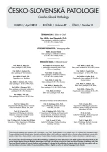How to improve the histopathological diagnosis of hepatocellular carcinoma in daily practice?
Authors:
E. Honsová; A. Lodererová
Authors‘ workplace:
Pracoviště klinické a transplantační patologie, Transplantcentrum IKEM, Praha
Published in:
Čes.-slov. Patol., 47, 2011, No. 2, p. 40-43
Category:
Reviews Article
Overview
Hepatocellular carcinoma (HCC) is one of the most common cancers in the world with an increasing incidence. Recently, an East-West consensus on the histopathologic criteria for the diagnosis of high-grade dysplastic nodules and early hepatocellular carcinoma was published. In addition to classical morphological criteria such as nucleocytoplasmic ratio, thickness of cell plates, mitotic index, and architectural disturbance, a new one – the stromal invasion – was recognized as a crucial criterion for the diagnosis of early HCC. Immunohistochemical detection of glypican-3 was shown as a specific marker for HCC that can be used to distinguish between the benign hepatocellular lesions and HCC.
Keywords:
early hepatocellular carcinoma – histopathology – glypican-3 – stromal invasion
Sources
1. Bosch X, Ribes J, Cléries R, Díaz M. Epidemiology of hepatocellular carcinoma. Clin Liver Dis 2005; 9: 191–211.
2. Ferenci P, Fried M, Labrecque D, et al. Hepatocellular carcinoma (HCC) a global perspective. J Clin Gastroenterol 2010; 44: 239–245.
3. Bruix J, Sherman M. Practice Guidelines Committee, American Association for the Study of Liver Diseases. Hepatology 2005; 42: 1208–1236.
4. International Consensus group for hepatocellular neoplasia. Pathologic diagnosis of early hepatocellular carcinoma: a report of the international consensus group for hepatocellular neoplasia. Hepatology 2009; 49: 658–664.
5. Filmus J. Glypican in growth control and cancer. Glycobiology 2001; 11: 19–23.
6. Coston W, Loera S, Lau SK, et al. Distinction of hepatocellular carcinoma from benign hepatic mimickers using Glypican-3 and CD34 immunohistochemistry. 2008; 32: 433–444.
7. Shirakawa H, Suzuki H, Shimomura M, et al. Glypican-3 expression is correlated with poor prognosis in hepatocellular carcinoma. Cancer Sci 2009; 100: 1403–1407.
8. Wang H, Anatelli F, Zhai QJ, et al. Glypican-3 as a useful diagnostic marker that distinguishes hepatocellular carcinoma from benign hepatocellular mass lesions. Arch Pathol Lab Med 2008; 132: 1723–1728.
9. Takai H, Kato A, Ishiguro T, at al. Optimization of tissue processing for immunohistochemistry for the detection of human glypican-3. Acta Histochem 2010; 112: 240–250.
10. Nakatsura T, Kageshita T, Ito S, et al. Identification of glypican-3 as a novel tumor marker for melanoma. Clin Cancer Res 2004; 10: 6612–6621.
11. Zynger DL, Everton MJ, Dimov ND, et al. Expression of glypican-3 in ovarian and extragonadal germ cell tumors. Am J Clin Pathol 2008; 130: 224–230.
12. Schwartz M, Dvorchik I, Roayaie S, et al. Liver transplantation for hepatocellular carcinoma: extensity of indications based on molecular markers. J Hepatol 2008; 49: 581–588.
Labels
Anatomical pathology Forensic medical examiner ToxicologyArticle was published in
Czecho-Slovak Pathology

2011 Issue 2
Most read in this issue
- Fibrosing cholestatic hepatitis – disease not only of transplanted patients. A report of eight cases
- Viral hepatitis at the beginning of the 21th century – value of liver biopsy in the context of development of new non-invasive diagnostic methods and in relation to the modern therapy of chronic viral hepatitis
- Pseudoangiomatous stromal hyperplasia with giant cells in the female breast. No association with neurofibromatosis?
- How to improve the histopathological diagnosis of hepatocellular carcinoma in daily practice?
